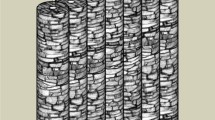Abstract
A sodium bentonite is being used in the basal-isolation of landfills installed on strongly fractured granitic rocks of N Portugal (NW Iberia). To evaluate the performance of this “clay” as the ultimate impermeable basal barrier, a detailed study was carried out of the granite fracture network; the Na-bentonite was tested to characterize its mechanical and geotechnical behavior; geophysical surveys were made to search for landfill leakage and the waters found around the landfill were geochemically characterized. Fractures in the granite are usually open and devoid of mineral infillings or clay materials and, thus, permeability of the granite is very high. Dispersal of contaminants can be further enhanced by the position of the landfill on a high steep-sided ridge. Geophysical and geochemical data show evidence for seepage and dispersion of pollutants, which means that the clay failed as an ultimate isolation barrier against seepage. This investigation shows that this can be due to fracturing of the clay under load and/or to its non-homogeneous saturation and extreme shrinking character upon drying, which are accompanied by the formation of extensive cracking. Observations and experimental results suggest that the use of synthetic “clays” in the safe building of landfill bottom liners needs further research, and extreme care should be taken in preventing that clay water content suffers large variations after saturation, as this process considerably degrades the mechanical behavior and sealing properties of the studied Na-bentonite.








Similar content being viewed by others
References
ASTM D427-98 (1998) Standard test method for shrinkage factors of soils by the mercury method. ASTM International, USA
ASTM D4318-00 (2000) Standard test methods for liquid limit, plastic limit, and plasticity index of soils. ASTM International, USA
Bagchi A (1994) Design, construction and monitoring of landfills, 2nd edn. Wiley, New York
Bowles J E (1984) Physical and geotechnical properties of soils, 2nd edn. McGraw-Hill Int, Ed
Egloffstein AT (2001) Natural bentonites-influence of the ion exchange and partial dessication on permeability and self-healing capacity of bentonites used in GCLs. Geotextiles and Geomembranes 19:427–444
Instituto Nacional de Resíduos (INR) (2000) Produção de resíduos sólidos urbanos/2000. Ministério do Ambiente. Lisboa
LNEC (1967) Soil swelling test. Especificação LNEC E200–1967. Laboratório Nacional de Engenharia Civil, Portugal
Mancktelow NS (1988) An automated machine for pure shear deformation of analogue materials in plane strain. J Struct Geol 10:101–108
Marques FO (2001) Flow and fracturing of clay: analogue experiments in bulk pure shear. In: Koyi HA, Mancktelow NS (eds) Tectonic modeling: a volume in honor of Hans Ramberg. Geological Society of America, Memoir 193:261–270
Marques FO, Mateus A, Amaral H, Gonçalves MA, Tassinari C, Silva P, Miranda JM (2001) The Amares basin: an ENE-WSW graben formed by recent reactivation of the late-Variscan fracture network? Comunicações Instituto Geológico e Mineiro 88:35–50
Marques FO, Mateus A, Tassinari C (2002) The late-Variscan fault network in central-northern Portugal (NW Iberia): a re-evaluation. Tectonophysics 359:255–270
Mateus A, Marques FO, Monteiro Santos F, Figueiras J, Gonçalves MA, Mota R, Amaral H, Silva P, Miranda M, Almeida C (2002) Fluid flow in fractured rocks and its implications for waste disposal criteria. Fundação para a Ciência e Tecnologia –Portugal, Research Project PRAXIS XXI/P/CTE/11028/98, Final Report
Mateus A, Gonçalves MA, Marques FO, Monteiro Santos F (2003) Multi-scale geometrical analysis of fracture networks in granite massifs and its application to landfill site selection. “A Geologia de Engenharia e os Recursos Geológicos”, Coimbra, Portugal. Eng Geol 1:79–91
Mota R, Monteiro Santos FA, Mateus A, Marques FO, Gonçalves MA, Figueiras J, Amaral H (2004) Granite fracturing and incipient pollution beneath a recent landfill facility as detected by several geoelectrical surveys. J Appl Geophys 57:11–22
Reches Z, Dieterich JH (1983) Faulting of rocks in three-dimensional strain fields: I. Failure of rocks in polyaxial, servo-control experiments. Tectonophysics 95:111–132
Rowe RK, Sangam HP (2002) Durability of HDPE geomembranes. Geotextiles Geomembranes 20:77–95
Acknowledgements
This is a contribution to Projects DIWASTE (PRAXIS XXI/P/CTE/11028/98) and GEOMODELS (POCTI/CTA/32742/99 and POCTI/CTA/38695/2001) and TEAMINT (POCTI/CTA/48137/2002). Experimental work and geotechnical characterization were performed in the Experimental Tectonics Lab of LATTEX and in Centro de Geologia Labs, respectively. Patrícia Conceição (CREMINER-FCUL) is thanked for technical support in X-Ray diffractometry analysis. The quality of this paper benefited from the comments of an anonymous reviewer.
Author information
Authors and Affiliations
Corresponding author
Rights and permissions
About this article
Cite this article
Marques, F.O., Marques, F.M.S.F., Mateus, A. et al. The effectiveness of “clay” liners as basal isolation of landfills: a case study. Environ Geol 47, 1128–1137 (2005). https://doi.org/10.1007/s00254-005-1247-9
Received:
Accepted:
Published:
Issue Date:
DOI: https://doi.org/10.1007/s00254-005-1247-9




